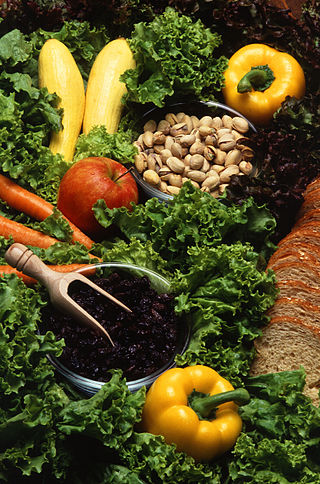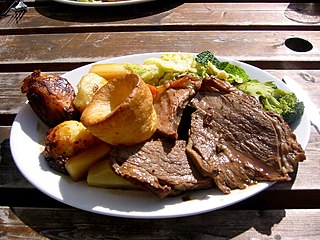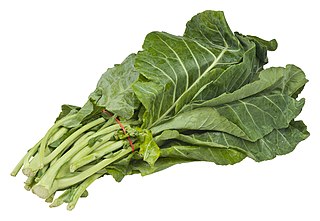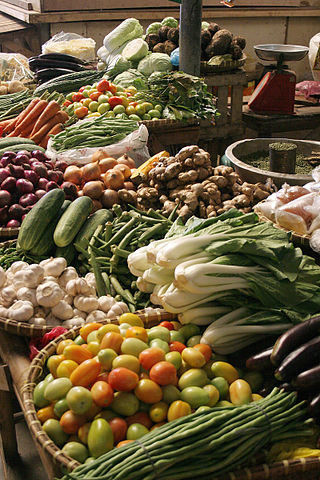Related Research Articles

Vegetarian cuisine is based on food that meets vegetarian standards by not including meat and animal tissue products. Lacto-ovo vegetarianism includes eggs and dairy products. Lacto vegetarianism includes dairy products but not eggs, and ovo vegetarianism encompasses eggs but not dairy products. The strictest form of vegetarianism is veganism, which excludes all animal products, including dairy, honey, and some refined sugars if filtered and whitened with bone char. There are also partial vegetarians, such as pescetarians who eat fish but avoid other types of meat.

Scotch broth is a filling soup, originating in Scotland. The principal ingredients are usually barley, stewing or braising cuts of lamb, mutton or beef, root vegetables, and dried pulses. Cabbage and leeks are often added shortly before serving to preserve their texture, colour and flavours. The proportions and ingredients vary according to the recipe or availability. Scotch broth has been sold ready-prepared in tins for many years.

A salad is a dish consisting of mixed, mostly natural ingredients. They are typically served at room temperature or chilled, though some can be served warm. Condiments and salad dressings, which exist in a variety of flavors, are often used to enhance a salad.

A Sunday roast or roast dinner is a traditional meal of British and Irish origin. Although it can be consumed throughout the week, it is traditionally consumed on Sunday. It consists of roasted meat, mashed potatoes, roasted potatoes and accompaniments such as Yorkshire pudding, stuffing, gravy, and condiments such as apple sauce, mint sauce, or redcurrant sauce. A wide range of vegetables can be served as part of a roast dinner, such as broccoli, Brussels sprouts, cabbage, carrots, cauliflower, parsnips, or peas, which can be boiled, steamed, or roasted alongside the meat and potatoes.

Sprouting is the natural process by which seeds or spores germinate and put out shoots, and already established plants produce new leaves or buds, or other structures experience further growth.

Collard is a group of certain loose-leafed cultivars of Brassica oleracea, the same species as many common vegetables including cabbage and broccoli. Collard is generally described as part of the Acephala (kale) cultivar group, but gets its own variety as Brassica oleracea var. viridis. The name "collard" comes from the word "colewort".

Leaf vegetables, also called leafy greens, pot herbs, vegetable greens, or simply greens, are plant leaves eaten as a vegetable, sometimes accompanied by tender petioles and shoots. Leaf vegetables eaten raw in a salad can be called salad greens.

Penang cuisine is the cuisine of the multicultural society of Penang, Malaysia. Most of these cuisine are sold at road-side stalls, known as "hawker food" and colloquially as "muckan carts". Local Penangites typically find these hawker fares cheaper and easier to eat out at due to the ubiquitousness of the hawker stalls and that they are open for much of the day and night. Penang island. On February 22, 2013, Penang was ranked by CNN Travel as one of the top ten street food cities in Asia. Penang has also been voted by Lonely Planet as the top culinary destination in 2014.

Ash, sometimes transliterated as aush or āsh, is a variety of thick noodle soups, which are usually served hot and is part of Iranian cuisine and Afghan cuisine. It is also found in Azerbaijani, Turkish, Pakistani, and Caucasian cuisine.

Vegetables are parts of plants that are consumed by humans or other animals as food. The original meaning is still commonly used and is applied to plants collectively to refer to all edible plant matter, including the flowers, fruits, stems, leaves, roots, and seeds. An alternative definition of the term is applied somewhat arbitrarily, often by culinary and cultural tradition. It may exclude foods derived from some plants that are fruits, flowers, nuts, and cereal grains, but include savoury fruits such as tomatoes and courgettes, flowers such as broccoli, and seeds such as pulses.

Olericulture is the science of vegetable growing, dealing with the culture of non-woody (herbaceous) plants for food.
Winter greens are green leaved vegetables, closely related to the cabbage, that are seasonably available in winter.

A staple food, food staple, or simply a staple, is a food that is eaten often and in such quantities that it constitutes a dominant portion of a standard diet for a given person or group of people, supplying a large fraction of energy needs and generally forming a significant proportion of the intake of other nutrients as well. A staple food of a specific society may be eaten as often as every day or every meal, and most people live on a diet based on just a small number of food staples. Specific staples vary from place to place, but typically are inexpensive or readily available foods that supply one or more of the macronutrients and micronutrients needed for survival and health: carbohydrates, proteins, fats, minerals, and vitamins. Typical examples include tubers and roots, grains, legumes, and seeds. Among them, cereals, legumes, tubers, and roots account for about 90% of the world's food calories intake.
The Future 50 Foods report, subtitled "50 foods for healthier people and a healthier planet", was published in February 2019 by the World Wide Fund for Nature (WWF) and Knorr. It identifies 50 plant-based foods that can increase dietary nutritional value and reduce environmental impacts of the food supply, promoting sustainable global food systems.

Aush jushpare is a type of aush, commonly cooked in Khorasan, Gonabad, Ferdous and Sabzevar in Iran. It is similar to the Chinese jiaozi. Historian Bayhaqi (-1077) mentioned about Aush Jushpare in his book "Tarikh-i Bayhaqi". Aush Jushpare is one of the oldest Aush, but since it takes a lot of time for preparation, it is not commonly eaten now. It is rather a dish of hospitality, which people eat on the occasion of special gatherings or festivals. Traditional guest house restaurant serves Aush Jushpare as local specialty. Aush Jushpare was registered as intangible heritage of Iran on 5 January 2021.
References
- ↑ "Non-starchy Vegetables". Food for Diabetics. American Diabetes Association. Retrieved 8 February 2012.
- ↑ Dolson, Laura. "Low Carb Diets". Low Carb Dieting. Retrieved 8 February 2012.
- ↑ "Non-starch Veg List" (PDF). Archived from the original (PDF) on 17 April 2012. Retrieved 8 February 2012.